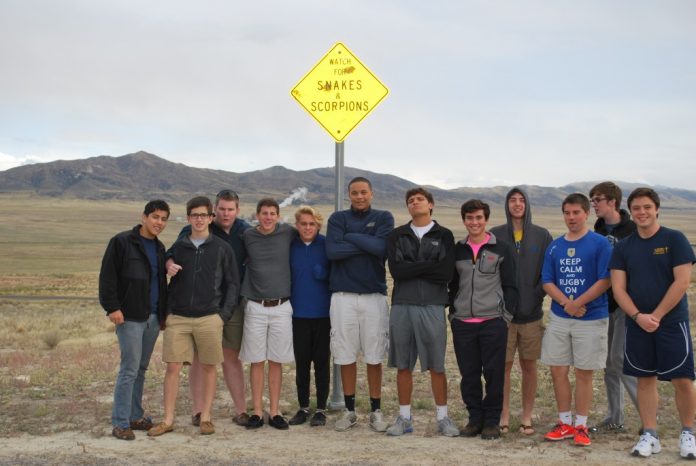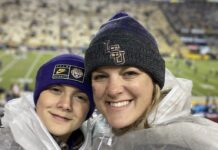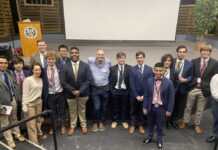Flying high over the plains, gliding smoothly in the thin air, the dark Harris’s hawk looks across the landscape for its next meal. With unparalleled vision and speed, this predatory bird rules the skies. At the top of the food chain, not threatened by any other animal, the hawk travels serenely. Darting its beady yellow eyes to the right at the slightest movement, the hawk pulls in its wings and dives down towards a slithering snake below. Darting through the air soundlessly, the hawk extends its black talons just a short distance from the ground, opening its wings to slow its incredible speed. In one swift motion, the hawk’s sharp claws slice through the snake, killing it almost instantly, and flies away almost unimpeded with its prize.
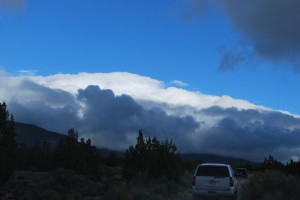 In the hope of creating and studying the statistical analyses of predatory birds like the Harris’s hawk, statistics teacher Mrs. Kelli Mattacchione, Principal Tom Garrison, and twelve seniors enrolled in statistics, in coordination with Hawk Watch International, traveled all the way to the Goshute Mountains in northeastern Nevada to tag the raptors of the area for study. They will research their migration and other lifestyle patterns.
In the hope of creating and studying the statistical analyses of predatory birds like the Harris’s hawk, statistics teacher Mrs. Kelli Mattacchione, Principal Tom Garrison, and twelve seniors enrolled in statistics, in coordination with Hawk Watch International, traveled all the way to the Goshute Mountains in northeastern Nevada to tag the raptors of the area for study. They will research their migration and other lifestyle patterns.
Using the data they collect to “understand the histories, ecology, status, and conservation needs of raptor populations in North America,” Hawk Watch International sees these raptors as a valuable resource for research. With a mission statement “to conserve the environment through education, long-term monitoring, and scientific research on raptors as indicators of ecosystem health,” the organization welcomes groups of students like Jesuit’s to pursue an active role in preserving the environment. Extending far beyond the study of the birds themselves, Hawk Watch International studies these fierce predators as a means to protect and monitor the surrounding biosphere.
Overseeing all of the Jesuit operations, Hawk Watch International must also follow a very strict set of guidelines to handle the raptors. Having obtained special permits and closely monitoring all of their activities, their site in the Goshute Mountains emphasizes utmost care when dealing with these birds.
Although used to observe raptor migrations, the Goshute Mountains location offers much more than a place for study. Hawk Watch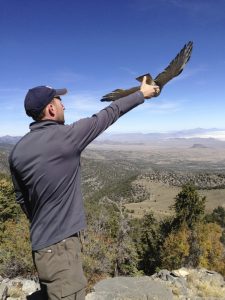 International is very proud of this site, saying that it “offers an unparalleled opportunity to explore a pristine part of [the] Nation’s public lands while witnessing the raptor migration,” a place of undisturbed natural beauty.
International is very proud of this site, saying that it “offers an unparalleled opportunity to explore a pristine part of [the] Nation’s public lands while witnessing the raptor migration,” a place of undisturbed natural beauty.
Excited to be a part of this effort and explore the incredible landscape, the statistic guys flew into Salt Lake City, Utah on the September 26, looking forward to their upcoming hike and tagging. After an uneventful flight, the group began their drive across state lines.
Along their journey, the group stopped to look at the Salt Flats of Nevada, exploring the expansive area known for its use in drag racing. The Salts Flats provided a great stop for the trip as the students got to hear their steps make a gentle crunch through what seemed like a snowy wonderland. Some even got down and licked the salt, taking in all that they could. After a short drive to Wendover and a short stretch of off-roading to get to the trail-head, the group had arrived and the guys were ready to get started.
Taken off guard by the frigid mountain air, the group did their best to stay warm. With temperatures dropping below freezing, each of the members slept in six-person tents that had no form of heating, leaving them to their own devices to stay warm. Some students improvised, forming their shirts into ski masks of sorts, retaining heat in any way they could. Of all the things on the trip, Mrs. Mattacchione said that the “only negative that [she] heard from the guys was how cold it was the first night.”
Hiking up the mountain the next day, the crew set off with all their belongings strapped to their back, taking a three mile trip to reach the top. Mrs. Mattacchione saw this as one of her peak experiences, saying “climb a mountain with thirty pounds of things on my back…I didn’t know I could do that.”
Overlooking the beautiful Nevada scenery, the summit provided a great location to see the expanse of the hawk’s dominion.
 Now at the site of the tagging effort, a project of Hawk Watch International, the Jesuit group was ready to get started with the field work of tagging birds. With an intention to tag birds and release them to their natural habitat, the project used a setup meant to lure these predatory birds into nets. Calling out to the instructors for incoming hawks, students worked to bring the birds into the net. Incapable of escaping, the birds would struggle until students came and retrieved them.
Now at the site of the tagging effort, a project of Hawk Watch International, the Jesuit group was ready to get started with the field work of tagging birds. With an intention to tag birds and release them to their natural habitat, the project used a setup meant to lure these predatory birds into nets. Calling out to the instructors for incoming hawks, students worked to bring the birds into the net. Incapable of escaping, the birds would struggle until students came and retrieved them.
Placing the birds headfirst into Pringles cans, students had to be wary of the piercing claws of the hawks, constantly aware of where they were holding the bird. With retrieving, tagging, and releasing the birds, the fact that the birds were dangerous, wild animals remained at the forefront of their minds, making sure to grip to where neither the beak nor claws could harm them.
Students especially enjoyed releasing the raptors, loving the feeling of letting the swift fliers loose. Antonio Gonzalez ’14 even said that it was “one of the best moments of [his] life,” to release the birds. Letting the birds go was a student favorite as they were able to physically interact with the birds that they would soon be doing statistical analyses on.
Hoping to “show a different side [of statistics],” Mrs. Mattacchione loved the fact that students were able to relate their statistical analysis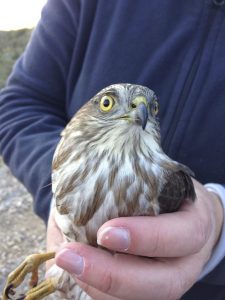 to something tangible in their lives. Rather than seeing meaningless numbers, students would identify patterns and ideas from their field work with the hawks. Making statistics a bit more personal, she hoped its value and concepts would be easier to understand. Charles Smith ’14 shared the same opinion, explaining that this project gave an excellent opportunity “to learn about gathering data in a fun and interesting way, and to see how statistics could be applied in real-life situations.”
to something tangible in their lives. Rather than seeing meaningless numbers, students would identify patterns and ideas from their field work with the hawks. Making statistics a bit more personal, she hoped its value and concepts would be easier to understand. Charles Smith ’14 shared the same opinion, explaining that this project gave an excellent opportunity “to learn about gathering data in a fun and interesting way, and to see how statistics could be applied in real-life situations.”
With that in mind, the authentic excitement and adrenaline rush from holding and releasing these birds could not be expressed in any statistical analysis. Charles said that his “favorite part was when [he] got to release a Cooper’s hawk,” a connection that was simply extraordinary.
Mrs. Mattacchione shared a similar opinion, saying that “catching and releasing hawks; you can’t forget that.” She commented that, “just the excitement and the thrill of a hawk diving towards us [was incredible.]” Coming directly into contact with some of nature’s most independent creatures was truly memorable for the travelers.
Aside from the work with the birds, the trip was full of breathtaking views and pleasant surprises. Nick Byrne ’15 put it simply: “it was a unique experience because I will probably never hike 2.6 miles up a mountain to catch hawks again.” Exceeding all expectations, the trip gave the Jesuit students an informative experience as well as invaluable memories.
 Charles shared this same joy in the small aspects of the trip, saying that “just sitting around with all the guys on top of a mountain just looking at the beautiful view” made the trip special for him.
Charles shared this same joy in the small aspects of the trip, saying that “just sitting around with all the guys on top of a mountain just looking at the beautiful view” made the trip special for him.
Antonio talked about how the trip in general was “extremely fun and a once in a lifetime opportunity,” something that will be remembered. Both the chance to be so close to the hawks as well as explore new uses of statistics made the trip a great learning experience.
Mr. Garrison shared the same enthusiasm, noting that he “was able to spend some time with a group of seniors that [he] may not have otherwise had the opportunity to spend any meaningful time with.” Enjoying the opportunity to see an educational trip executed seamlessly, Mr. Garrison appreciated the interactions that he had.
Along with sharing quality time with students, he “gained further insight into the ins and outs of traveling outside of the school with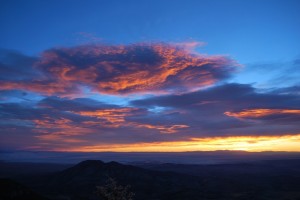 students for the purpose of enriching their learning experience inside the classroom.” Mr. Garrison had nothing but praise for the trip and how much the students gained from the trip. He was very impressed by the effectiveness of the experience, commenting that “Mrs. Mattacchione did a wonderful job of finding a trip that would be both academically meaningful, emotionally memorable, and impactful.” The combination of education and fun was masterful.
students for the purpose of enriching their learning experience inside the classroom.” Mr. Garrison had nothing but praise for the trip and how much the students gained from the trip. He was very impressed by the effectiveness of the experience, commenting that “Mrs. Mattacchione did a wonderful job of finding a trip that would be both academically meaningful, emotionally memorable, and impactful.” The combination of education and fun was masterful.
Sadly, at the end of three full days of experiencing the crisp, cool mountain air and getting to see the strength and beauty of predatory birds, it was time for the group to leave. After seeing what their field of math truly offered and how it related to the real world, these Jesuit seniors surely returned to Dallas with a different outlook on what was once just another math class.
Mrs. Mattacchione reflected on the trip, satisfied with the success, saying that for the whole weekend it was “all smiles.” Enjoying a weekend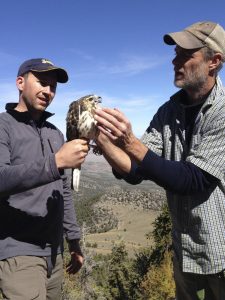 with each other, the group learned a great deal about raptors but a lot more about each other. The trip provided an opportunity for the group to come closer together as a whole. She was pleased to return to Dallas knowing that “everything turned out to be great and wonderful and the kids had so much fun.”
with each other, the group learned a great deal about raptors but a lot more about each other. The trip provided an opportunity for the group to come closer together as a whole. She was pleased to return to Dallas knowing that “everything turned out to be great and wonderful and the kids had so much fun.”
Happy for the camaraderie that they built, Charles talked about how the trip “was a great way to grow closer to [my] Jesuit Brothers,” providing the opportunity to hike, work, camp, and relax together. Unified in their pursuit of knowledge and in the experience, these seniors shared a community experience that will be fondly remembered for years to come.
And although the trip was centered on the raptors of Nevada, it was ultimately defined by the unexpected surprises. Between the unexpected stop at the salt flats and the offroading to the camp site, the beautiful scenery and the serene hikes, there was much more to the trip than statistics and hawks.


